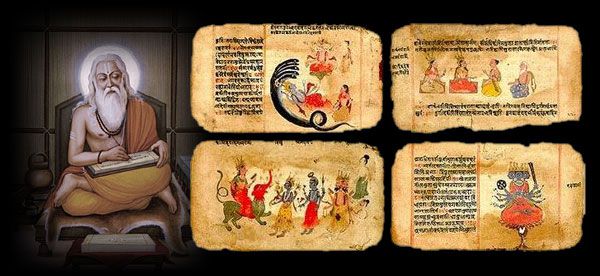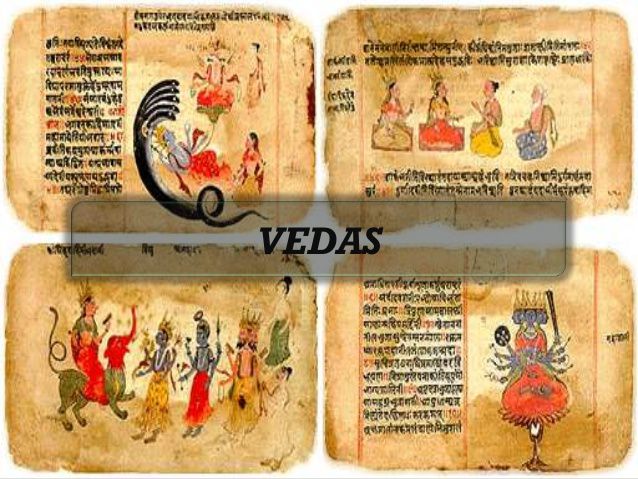No products in the cart.
The Vedas are an extremely large and comprehensive scripture that form the core of Hinduism. They are considered to be one of the integral scriptural foundations of Hinduism. Many Hindus believe that the Vedas were not written by anyone including Ishwar (the term used for God among the Hindus), but are eternally existing (apauruseya). While many historians regard the Vedas as some of the oldest surviving texts in the world, they estimate them to have been written down between 2500 and 500 BCE.
The Vedas are the most ancient books in the World, and they are the Foundation of Hinduism. Veda means knowledge. Any form of Knowledge acquired is considered as a Veda whereby it has no beginning or end. While it might surprise people how a book can have no beginning or end, the ancient Rishis who wrote these accepted that the complete knowledge of the Universe could never fit in any book, and so there would always be new things to discover. This philosophy makes Hinduism a very tolerant religion, always ready to accept new ideas from other cultures.
The motive of the Vedas is to help man to remain within the limitations of the Vedas despite having lost the spiritual emotion that ‘He is I’ by retaining awareness of the soul principle or at least to prevent him from becoming unhappy in the materialistic world. The Vedas are meant primarily to bestow the entire creation with happiness rather than to attain the Final Liberation (Moksha). The resultant benefit of a happy society is the Final Liberation. Due to smooth functioning of the cycle of Dharmacharan”>Righteousness (Dharma) and the Final Liberation society becomes happy. This it is cumulative merit (samashti punya). The Vedas are certainly overjoyed to see one individual liberated but they are even happier to see ninety-nine people making spiritual progress.
The Vedas are not meant merely for spiritual contemplation. They also contain worldly and divine concepts in them.
The Vedas were compiled by Krishna during the Dvapara Yuga with the goal to come up with a de-facto standard of education. Upon gathering all the teachings passed on from the Acharyas (Teachers) to their Sishya (Students) from Kingdom to Kingdom, he compiled them into 4 standard structures; Rig, Sama, Yajur and Atharvana are the four vedas Except that they were compiled by Veda Vyasa, the date of origin is not traceable. Hence it is difficult to say when the earliest part(s) of Vedas came into existence. The four Vedas are collectively known as “Chathurveda,” of which the first three Vedas viz., Rig Veda, Sama Veda and Yajur Veda agree in form, language and content. “Veda” means wisdom, knowledge or vision, and it manifests the language of the gods in human speech. The laws of the Vedas regulate the social, legal, domestic and religious customs of the Hindus to the present day. All the obligatory duties of the Hindus at birth, marriage, death etc. owe their allegiance to the Vedic ritual. They draw forth the thought of successive generation of thinkers, and so contain within it the different strata of thought.
The Rig Veda: The Book of Mantra
The Rig Veda is a collection of inspired songs or hymns and is a main source of information on the Rig Vedic civilization. It is the oldest book in any Indo-European language and contains the earliest form of all Sanskrit mantras that date back to 1500 B.C. – 1000 B.C. Some scholars date the Rig Veda as early as 12000 BC – 4000 B.C. The Rig-Vedic ‘samhita’ or collection of mantras consists of 1,017 hymns or ‘suktas’, covering about 10,600 stanzas, divided into eight ‘astakas’ each having eight ‘adhayayas’ or chapters, which are sub-divided into various groups. The hymns are the work of many authors or seers called ‘rishis’. There are seven primary seers identified: Atri, Kanwa, Vashistha, Vishwamitra, Jamadagni, Gautama and Bhardwaj. The rig Veda accounts in detail the social, religious, political and economic background of the Rig-Vedic civilization. Even though monotheism characterizes some of the hymns of Rig Veda, naturalistic polytheism and monism can be discerned in the religion of the hymns of Rig Veda.
The Sama Veda: The Book of Song
The Sama Veda is purely a liturgical collection of melodies (‘saman’). The hymns in the Sama Veda, used as musical notes, were almost completely drawn from the Rig Veda and have no distinctive lessons of their own. Hence, its text is a reduced version of the Rig Veda. As Vedic Scholar David Frawley puts it, if the Rig Veda is the word, Sama Veda is the song or the meaning, if Rig Veda is the knowledge, Sama Veda is its realization, if Rig Veda is the wife, and the Sama Veda is her husband.
The Yajur Veda: The Book of Ritual
The Yajur Veda is also a liturgical collection and was made to meet the demands of a ceremonial religion. The Yajur Veda practically served as a guidebook for the priests who execute sacrificial acts muttering simultaneously the prose prayers and the sacrificial formulae (‘yajus’). It is similar to ancient Egypt’s “Book of the Dead”. There are no less than six complete recessions of Yajur Veda – Madyandina, Kanva, Taittriya, Kathak, Maitrayani and Kapishthala.
The Atharva Veda: The Book of Spell
The last of the Vedas, this is completely different from the other three Vedas and is next in importance to Rig-Veda with regard to history and sociology. A different spirit pervades this Veda. Its hymns are of a more diverse character than the Rig Veda and are also simpler in language. In fact, many scholars do not consider it part of the Vedas at all. The Atharva Veda consists of spells and charms prevalent at its time, and portrays a clearer picture of the Vedic society.
It is believed that humans did not compose the revered compositions of the Vedas, which were handed down through generations by the word of mouth from time immemorial. The general assumption is that the Vedic hymns were either taught by God to the sages or that they were revealed themselves to the sages who were the seers or “mantradrasta” of the hymns.

The preaching’s in the four vedas are related to the four Yugas viz., Satya, Treta, Dvapara and Kaliyuga. We are now living in the last one, Kaliyuga. In Kali Yuga, the knowledge and power of man is confined to the world of gross matter (Bhu Loka, first sphere,) and his state is dependent of Nature. During this Yuga, his mind is centered on the problems of material objectivity, the Avidya of Atomic Form. Vedas may have more relevance to especially Kaliyuga which is left with only 25%.truth (In Satya 100% truth prevailed; in Treta 25% of truth lost, in Dvapara 50%), a world which is infested with impurities and vices. People possessing genial virtues diminishing day by day. Floods and famine, war and crime, deceit and duplicity characterize this age.
Trying to understand the Vedas is a good augury in Kaliyuga but it is a Himalayan task. It is more so to follow them in our day-to-day life.
Each of the four Vedas has the following three parts;
The Samhitas
The Samhitas form the first part of each of the Vedas. A Samhita is a collection of mantras, so the Samhitas are sometimes also referred to as the ‘mantras’. Most of the mantras or hymns were concerned with the nature and the deities. The ancient man worshipped the elements of nature as deities though it is believed that these deities are symbolic.
Generally, the mantras are addressed to the Gods and Goddesses. Some Western scholars believe that the Vedic man used the mantras in sacrificial ceremonies and for performing mystic rituals. This may be true for a number of mantras. Apparently, many mantras or hymns were meant for devotional or ceremonial purposes. In fact, they seem to be symbolic and need exceptional scholastic efforts to decipher them.
Swami Dayananda Saraswati made extraordinary efforts to bring out the significance of the mantras of the Vedas. Shri Aurobindo also challenged the Western philosophers and opined that the mantras are found to express esoteric truths which the Westerners cannot grasp. He strove hard to elucidate the cryptic meanings of the Vedic words and the hymns.
The Samhitas are named after the Vedas they belong to. For example, the Samhita of the Rig Veda is called the Rig-Veda-Samhita or the Rig-Samhita.
The Rig-Samhita contains the mantras or the hymns known as ‘richas’. These hymns are metered verses. The Sam-Samhita contains mantras in the form of songs meant for liturgy or public worship. The Yajur-Samhita contains verities of mantras composed in the poetical and the prose forms. The Atharva-Samhita contains mantras meant for routine rites and rituals.
The Brahmanas
The Brahmanas constitute the second part of the Vedas.
With the passage of time, the newer generations found the mantras of the Samhitas difficult to understand. An elaborate explanation of the mantras became necessary. The result was the Brahmanas. The Brahmanas are explanatory in nature.
The Brahmanas, the second part of the Vedas, are mostly in prose. The word ‘Brahmana’ has its root in the word ‘brahman’ which means ‘prayer’ or ‘devotion’. The word ‘brahman’ is distinct from the word ‘Brahman’ which means ‘the immanent Power’. The Brahmanas hint at ‘the magic’ or ‘the secret power’ of the sacrificial rituals.
The Brahmanas are concerned with the religious rites and rituals. But their covert meanings often baffle the researchers. The Indian scholars differ from their Western counterparts.
The Rig Veda has two Brahmanas – Aitereya Brahmana and Shankhayana Brahmana.
The Shat-Patha Brahmana of Yajur Veda is the largest of all the Brahmanas of all the Vedas.
The Aranyakas
The Aranyakas form the third part of the Vedas. However, it should be noted that the Aranyakas are sometimes considered as parts of the Brahmanas.
The Sanskrit word ‘aranya’ means a forest.
The Aranyakas were developed by the hermits, living in the forests. Due to the limited resources in the forests, they could not perform the conventional sacrifices, nor could they adhere to the rituals. It was then that the Aranyakas were developed.
With the advent of the Aranyakas, the emphasis on the sacrificial rites seems to be diluting. The shift towards philosophic and spiritual interpretation of the rituals and ceremonials is evident.
The Aranyakas reflect an explicit transition in the philosophy of life of man. The speculative and intuitive thinking seems to be developing. Meditative thinking is conspicuous. The Vedic man seems to be turning from the gross to the subtle. His quest for knowledge seems to be intensified.






